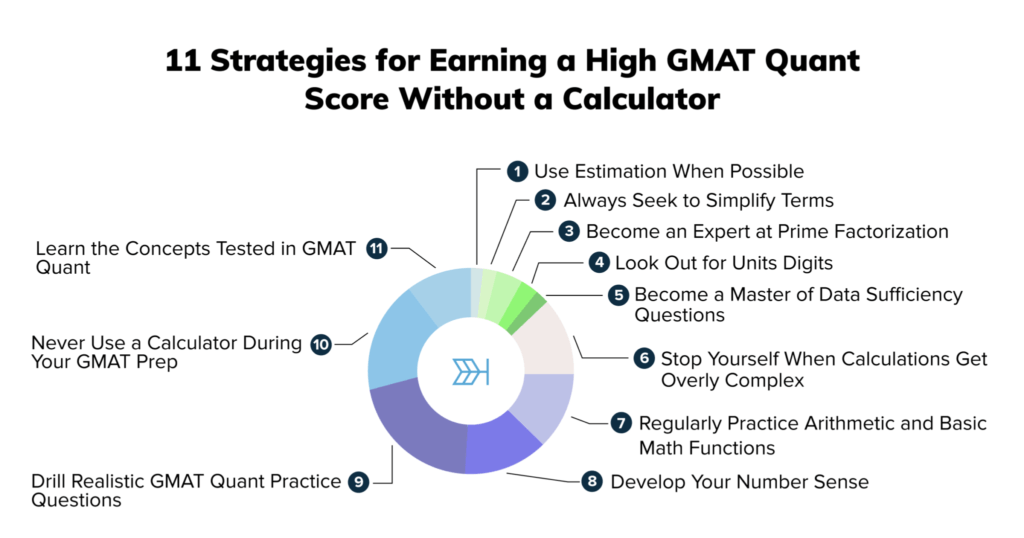Guest article by Scott Woodbury-Stewart, Founder & CEO, Target Test Prep
Many GMAT test-takers, particularly those who don’t consider math their strongest subject, start to panic when they learn that they won’t have access to the GMAT calculator for the Quant section of the exam.
The truth is that — unless there are special circumstances involving accommodations — no student, regardless of his or her starting math proficiency, needs a calculator to do GMAT Quant. In fact, GMAT Quant questions are specifically designed to be answered without the use of a calculator. This is because GMAT Quant tests your use of logic and your conceptual knowledge, not your ability to perform complex mathematical calculations.

Infographic by Target Test Prep
Remember, the GMAT assesses your skill in areas that will be important in business school; being able to efficiently input numbers into a calculator isn’t going to tell admissions committees much about your readiness for an MBA program. Thus, if you want to earn a high GMAT Quant score, you should think of it not as a math test, but as a logic test.
Of course, earning a competitive Quant score takes more than just a change in mindset. In my recent article for Target Test Prep, I discuss 11 key strategies that every test-taker needs to conquer GMAT Quant without the use of a calculator:
- Learn the Concepts Tested in GMAT Quant.
- Drill Realistic GMAT Quant Practice Questions.
- Regularly Practice Arithmetic and Basic Math Functions.
- Use Estimation When Possible.
- Always Seek to Simplify Terms.
- Develop Your Number Sense.
- Look Out for Units Digits.
- Become an Expert at Prime Factorization.
- Become a Master of Data Sufficiency Questions.
- Stop Yourself When Calculations Get Overly Complex.
- Never Use a Calculator During Your GMAT Prep.
Strategy 1: Learn the Concepts Tested in GMAT Quant.
When you begin familiarizing yourself with the content tested in GMAT Quant, you’ll quickly see that the content is quite conceptual in nature. In other words, the questions you face are not calculation-heavy.
Let’s look at a few examples of tasks you could be asked to complete in the Quant section of the GMAT. For each set of tasks, note that the task you may be asked to perform on the GMAT does not require a calculator, while the task you would never be asked to perform would require a calculator.
You may be asked to … Determine whether the standard deviation of a set is zero.
You’ll never be asked to … Calculate the standard deviation of a set of numbers.
You may be asked to … Determine the remainder when 299 is divided by 3.
You’ll never be asked to … Divide 299 by 3.
You may be asked to … Determine the sum of the first 100 positive even integers.
You’ll never be asked to … Calculate the product of the first 100 positive even integers.
Now, if you can’t yet recognize why the first task in each set doesn’t require a calculator to complete, don’t worry; as you learn how to recognize which concept is being tested in a given question and how to apply that concept to efficiently answer the question, you’ll see that you don’t need a calculator after all. The key is to find a rigorous, comprehensive, trusted GMAT prep course, so that you can master the material tested.
Strategy 2: Drill Realistic GMAT Quant Practice Questions.
While the first step in mastering GMAT Quant is to learn the content tested, the next step is to practice applying the principles and concepts you’ve learned. By engaging in extensive topical practice, you’ll refine your skills at recognizing which concepts questions involve and make using efficient methods to solve GMAT Quant questions second nature. Consider the following question, for example:
What is the units digit of 749?
Upon seeing this question, was your first reaction that the only way to solve this problem is by using a calculator? If so, you’re not alone. The good news is that there is an elegant solution for questions involving units digit patterns, and that solution does not require a flurry of intricate calculations on a calculator. Check out the solution to the above question:
Solution:
Turning back to the units-digit matrix, we find that the units-digit pattern for powers of 7 is 7–9–3–1. Thus, all powers of 7 that are multiples of 4 have a units digit of 1. The closest multiple of 4 to 49 is 48. This means that 748 has a units digit of 1. Then, 749 has a units digit of 7.
Answer: D
Once you understand the methods used to obtain the units digit of 749, this problem becomes relatively easy. However, developing the skills to attack problems such as this one certainly does not happen overnight. You have to practice many problems of each question type tested on the GMAT to ensure that you’ve gained mastery. That is why the TTP course contains more than 30 problems just on units digit patterns. After you answer 30 questions involving this concept, the skills you need to attack such questions will be second nature.
We’ll discuss units digit patterns more a little later, but keep in mind that a “practice makes perfect” mentality applies to every other Quant concept as well.
Strategy 3: Regularly Practice Arithmetic and Basic Math Functions.
Although GMAT Quant doesn’t require complex calculations, you will need to perform some basic math to answer certain questions. Force yourself to master basic operations, such as multiplication, division, addition, and subtraction, using pen and paper. The more you practice, the more comfortable you’ll become at, say, multiplying 37 by 41 or dividing 996 by 6 without using a calculator. Many of us have gotten used to letting a calculator do the work when it comes to even the simplest calculations, but in reality, calculations such as these don’t require much time or effort if you’re used to performing them.
If the sight of 67 x 101 or similar calculations gives you heart palpitations, you need to regularly practice doing mild multiplication and division problems by hand, so that, when you encounter similar math on test day, you have no issues efficiently multiplying or dividing numbers without a calculator.
A good way to practice basic calculations, in addition to doing GMAT Quant problems, is to stop using your calculator (whenever you can) in everyday life. For example, if you need to figure out the sale price of a $175 item that is marked down by 15%, rather than using your calculator, write out the calculation. If you need to split a $250 dinner check 6 ways, again, write out the division by hand and do the calculation. The more you practice basic operations, the more prepared you’ll be to use them on the actual GMAT.
For the deep dive on all 11 strategies, view my full article on Target Test Prep’s blog.
Want more advice?
To learn more about why the GMAT matters to top MBA programs and how to prepare, read our related articles:
- How to Increase Your GMAT Score: Tips from Test Prep Experts
- 7 Essential Tips for GMAT Prep
- GMAT Prep Strategies: How to Study While Working
- What MBA Candidates Need to Know About the Online GMAT
- How You Can Learn to Love the GMAT (and Why it Matters to B-schools
- Top MBA Programs Offering GMAT Test Waivers (Should You Ask for One?)
For a candid assessment of your chances of admission success at a top MBA program, sign up for a free consultation with Fortuna Admissions.
Scott Woodbury-Stewart is the founder & CEO of Target Test Prep. A passionate teacher who is deeply invested in the success of his students, Scott began his career teaching physics, chemistry, math, and biology. Since then, he has spent more than a decade helping students gain entry into the world’s top business schools, logging 10,000+ hours of GMAT instruction.
